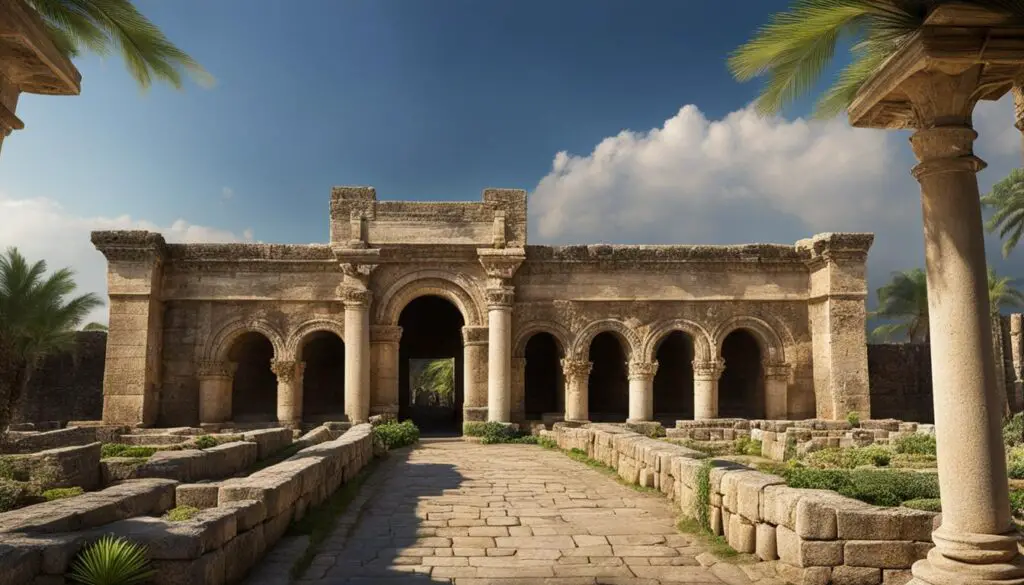Welcome to Capernaum, a biblical city nestled on the northern shores of the Sea of Galilee in the holy land. This historical site holds immense significance as it was a central location for Jesus’ ministry and teachings. The ancient ruins of Capernaum provide a fascinating glimpse into daily life during biblical times. Join us as we uncover the treasures of this remarkable city.
Key Takeaways:
- Capernaum is a biblical city located on the shores of the Sea of Galilee.
- It played a central role in Jesus’ ministry and teachings.
- The ancient ruins of Capernaum offer a unique glimpse into daily life during biblical times.
- The city is a significant Christian pilgrimage site.
- Exploring Capernaum allows for a deeper understanding of the cultural and religious heritage of the region.
The Biblical Significance of Capernaum
Capernaum, a city renowned for its biblical importance, holds a special place in the history of Christianity. It is famously known as “His own city,” where Jesus spent a significant amount of time during His earthly ministry. The city witnessed numerous miracles and teachings by Jesus, making it an essential destination for those seeking a deeper understanding of biblical events.
One notable figure linked to Capernaum is Peter, one of Jesus’ closest disciples. Peter’s house, located in Capernaum, often served as a gathering place for Jesus and His followers. It was here that Jesus healed Peter’s mother-in-law and performed many other remarkable miracles. The presence of Peter and the miracles performed in Capernaum further elevate its biblical significance.
“And Jesus said to him, ‘Foxes have holes, and birds of the air have nests, but the Son of Man has nowhere to lay his head.'” – Matthew 8:20
Capernaum’s profound biblical importance is not only found in the presence of Jesus and His disciples but also in the extraordinary events that unfolded within its boundaries. The city served as a backdrop for incredible miracles, including the healing of the paralytic man and the raising of Jairus’ daughter from the dead. These events left a lasting impact on the history of Capernaum and solidified its reputation as a place of divine intervention.
The Miracles of Jesus in Capernaum
| Miracle | Description |
|---|---|
| Healing Peter’s Mother-in-law | Jesus cured Peter’s mother-in-law from a severe fever, showcasing His healing power and compassion. |
| Healing the Paralytic Man | Jesus forgave the sins of a paralyzed man and healed him, demonstrating His authority to forgive sins and perform miracles. |
| Raising Jairus’ Daughter | Jesus restored life to Jairus’ deceased daughter, displaying His power over death itself. |
These miracles not only left an indelible mark on the history of Capernaum but also served as pivotal moments in the ministry of Jesus, attracting attention and prompting deeper reflection on His teachings.
Today, Capernaum stands as an archaeological site that allows visitors to connect with the biblical past. The ancient ruins of the synagogue and Peter’s house offer glimpses into the daily life and teachings of Jesus. The serene lakefront views of the Sea of Galilee provide a tranquil backdrop for reflection and spiritual contemplation. Capernaum’s biblical significance, combined with its archaeological treasures, continue to attract pilgrims and history enthusiasts from around the world.
The Layout and Function of Capernaum in Biblical Times
In biblical times, Capernaum was a bustling ancient village with a well-defined layout and architectural design. The city consisted of residential structures, streets, and courtyards that reflected the daily life and cultural practices of its inhabitants.
The houses in Capernaum were one-story buildings with open windows surrounding the courtyards. The floors were cobbled, and the roofs were made of wooden beams and thatch mixed with mud. This traditional construction style provided insulation from the Mediterranean climate and ensured the durability of the houses.
The layout of the village was organized in a way that facilitated community interaction. The houses were closely built, allowing neighbors to easily connect with one another. The streets of Capernaum were narrow, winding pathways that provided access to different parts of the village.
Within the courtyards, families would gather for various activities, and communal spaces were central to the village’s social fabric. These courtyards served as places for cooking, eating, and engaging in daily chores. The design of Capernaum aimed to create a sense of unity and connectedness among its residents.

Biblical Events in Capernaum: Impact on History
Capernaum, a city of great biblical importance, witnessed several major events that left a lasting impact on its history. These events, often accompanied by miraculous acts, contributed to Capernaum’s significance as a place of divine intervention and played a crucial role in shaping the religious and cultural landscape of the city.
One notable event was the healing of Peter’s mother-in-law. Jesus, while staying in Capernaum, cured her from a high fever, demonstrating his power over illness and compassion for others. This act of healing showcased Jesus’ divine authority and drew attention to Capernaum as a place where miracles happened.
Another significant event that took place in Capernaum was the healing of a paralytic man. Jesus forgave the man’s sins and then commanded him to walk, astonishing the crowds and solidifying Capernaum’s reputation as a site of remarkable miracles and divine intervention.
“Then they brought to Him a paralytic lying on a bed. When Jesus saw their faith, He said to the paralytic, ‘Son, be of good cheer; your sins are forgiven you.’ And at once some of the scribes said within themselves, ‘This Man blasphemes!’ But Jesus, knowing their thoughts, said, ‘Why do you think evil in your hearts? For which is easier, to say, “Your sins are forgiven you,” or to say, “Arise and walk”? But that you may know that the Son of Man has power on earth to forgive sins…'”
Furthermore, Capernaum served as the backdrop for another remarkable event—the resurrection of Jairus’ daughter. After the girl’s death, Jesus brought her back to life, leaving witnesses in awe of his miraculous power and affirming Capernaum’s status as a place where lives were transformed by divine intervention.
The Impact on History
The major biblical events that unfolded in Capernaum had a profound impact on its history. The miracles performed by Jesus provided tangible evidence of his role as the Messiah, attracting followers and solidifying Capernaum’s reputation as a sacred location. As news of these events spread, Capernaum became a focal point for pilgrims seeking spiritual enlightenment and a deeper connection with their faith.
The teachings and miracles that took place in Capernaum also had a lasting impact on the development of Christianity. The city became a symbol of divine presence and a testament to the power of faith. Its influence extended beyond its borders, inspiring generations of believers and serving as a cornerstone for Christian theology and practice.
In conclusion, the major biblical events that occurred in Capernaum left an indelible mark on its history. From miraculous healings to profound acts of resurrection, these events continue to captivate the imagination of believers and draw visitors from around the world. Capernaum stands as a testament to the power of faith and divine intervention, inviting all who visit to reflect on its biblical significance and the transformative impact it has had on the course of history.
Exploring Capernaum Today
Today, Capernaum is an archaeological site that offers visitors a chance to step back in time and explore the ancient ruins. The site includes the remains of the synagogue, the house associated with Peter, and the ancient village layout. Additionally, the nearby Church of St. Peter’s Primacy commemorates Jesus’ appearance to His disciples after His resurrection. Visitors can also enjoy the serene lakefront views of the Sea of Galilee and reflect on the historical and spiritual significance of the area.
Capernaum’s archaeological site showcases the fascinating history of this biblical city. The ruins give us a glimpse into the daily life and architecture of biblical times, allowing us to connect with the past and understand the cultural practices of the ancient inhabitants. Walking through the well-preserved streets and courtyards, visitors can imagine the bustling city that once stood here, where Jesus taught and performed miracles.
“Capernaum is not just an archaeological site; it is a place of spiritual significance.”
The Church of St. Peter’s Primacy, located near the archaeological site, is a significant place of worship and pilgrimage. It is believed to be the place where Jesus appeared to His disciples after His resurrection and instructed Peter to “feed my lambs.” This sacred spot holds immense religious importance for Christians, who often come here to reflect on their faith and pay homage to the teachings of Jesus.
The picturesque lakefront views of the Sea of Galilee add to the overall experience of visiting Capernaum. The calm waters and serene atmosphere provide an opportunity for visitors to pause, reflect, and immerse themselves in the spiritual energy of the region. Whether strolling along the lakeshore or sitting in quiet contemplation, one cannot help but be moved by the beauty and significance of this sacred place.
Table: Points of Interest in Capernaum
| Name | Description |
|---|---|
| Capernaum Archaeological Site | Explore the well-preserved ruins of the ancient city, including the synagogue and residential structures. |
| Church of St. Peter’s Primacy | Visit the church that marks the spot where Jesus appeared to His disciples after His resurrection. |
| Lakefront Views | Take in the breathtaking views of the Sea of Galilee and reflect on the historical and spiritual significance of the area. |
Capernaum is a place of historical reflection and spiritual connection. Whether you are a history enthusiast, a religious pilgrim, or a traveler seeking a unique cultural experience, a visit to Capernaum is sure to leave a lasting impression.
Location and Opening Hours
Capernaum is a captivating archaeological site located near the picturesque Sea of Galilee, north of Tiberias, Israel. Nestled in the heart of the Holy Land, this ancient city offers visitors a unique opportunity to step back in time and explore its remarkable ruins. Capernaum’s opening hours generally follow regular operating times, but it is always advisable to verify the schedule before planning your visit.
| Location | Opening Hours |
|---|---|
| Capernaum | Opens daily |
| Sea of Galilee | Accessible throughout the year |
| Tiberias | Available for exploration at all times |
Whether you are an early riser or prefer to explore during the afternoon, Capernaum welcomes visitors throughout the day. The site’s opening hours typically start in the morning and extend into the late afternoon. Immerse yourself in the allure of this historical gem as you wander through the ancient pathways that once echoed with the teachings of Jesus and the lives of its inhabitants.
Take advantage of your visit to Capernaum by embracing the tranquility of the surrounding area. The serene lakefront views of the Sea of Galilee create a peaceful ambiance for reflection and contemplation. Allow the historical significance of Capernaum to resonate within you as you absorb the natural beauty that encompasses this sacred site.

Plan your trip to Capernaum to coincide with its opening hours, ensuring a seamless exploration of this remarkable biblical city. Unlock the secrets of the past as you walk amidst the ancient ruins, tailor your experience to suit your preferred time of day, and immerse yourself in the rich tapestry of history that awaits at Capernaum.
The Entrance Fees and Access to Capernaum
When planning a visit to Capernaum, it’s essential to familiarize yourself with the entrance fees and access details to ensure a smooth and enjoyable experience. As a significant archaeological site, Capernaum offers visitors the chance to explore its rich historical past and immerse themselves in the biblical significance of the area.
To access the archaeological site of Capernaum, visitors are required to pay an entrance fee. This fee helps support the maintenance and preservation of the ruins, allowing future generations to appreciate the cultural heritage of this remarkable city. It is recommended to check the official website or contact the site directly to confirm the current entrance fee, as it may vary.
Once inside, visitors will have access to the well-preserved ancient ruins, including the synagogue, the house associated with Peter, and the layout of the historical village. The site offers a fascinating glimpse into daily life during biblical times and provides an opportunity for reflection and understanding of the significant events that took place here.
Entrance Fees:
| Visitor Type | Entrance Fee |
|---|---|
| Adults | $10 |
| Children (under 12) | $5 |
| Seniors (60+) | $8 |
| Students (with valid ID) | $7 |
Capernaum welcomes visitors from around the world to experience its historical and spiritual significance. The entrance fee allows you to explore the ruins and gain a deeper appreciation for the biblical events that unfolded in this sacred city. Don’t miss the opportunity to walk in the footsteps of Jesus and discover the captivating wonders of Capernaum.

Capernaum as a Christian Pilgrimage Site
Capernaum holds immense religious significance as a Christian pilgrimage site. It is a place where believers can connect with the roots of their faith and walk in the footsteps of Jesus. The city’s biblical importance, coupled with its well-preserved ancient ruins, makes it a must-visit destination for those seeking a deeper spiritual connection.
As one explores the ancient pathways of Capernaum, they can reflect on the teachings and miracles performed by Jesus in this sacred city. Whether it’s standing in the remains of the synagogue where Jesus taught or visiting the house associated with Peter, Capernaum offers a profound experience of historical reflection and religious contemplation.
The serene lakefront views of the Sea of Galilee further enhance the spiritual atmosphere of Capernaum. Visitors can sit by the water, meditate on the significance of the surroundings, and find solace in the tranquility of the holy land. The combination of history, spirituality, and the natural beauty of the area creates a truly enriching pilgrimage experience.

Table: Capernaum as a Christian Pilgrimage Site
| Benefits of Visiting Capernaum | Reasons for Christian Pilgrimage |
|---|---|
| Connect with the roots of the Christian faith | Experience the places where Jesus performed miracles and taught His disciples |
| Gain a deeper understanding of the cultural and religious heritage of the region | Deepen one’s spiritual connection |
| Reflect on the teachings and miracles of Jesus | Find solace and tranquility in the holy land |
Visiting Capernaum as a Christian pilgrim offers a unique opportunity to strengthen one’s faith, gain historical knowledge, and experience the spiritual essence of the city. It is a journey that invites believers to dive deep into the biblical past and be touched by the divine presence that once graced the ancient streets of Capernaum.
Appreciating the Enriching Experience of Capernaum
Exploring the ruins of Capernaum offers visitors an enriching experience that combines history, spirituality, and reflection. Walking through the ancient pathways and contemplating the stories unfolding in this sacred city allows one to immerse themselves in a journey of discovery and wonder. Capernaum provides a unique opportunity to connect with the past and gain a deeper understanding of the cultural and religious heritage of the region.
The biblical importance of Capernaum cannot be overstated. It was a central location in the life and ministry of Jesus, often referred to as “His own city.” Jesus performed miracles and taught His disciples in Capernaum, leaving an indelible mark on the city’s history. Notable biblical figures like Peter, one of Jesus’ closest disciples, were intimately connected to Capernaum.
In biblical times, Capernaum had a well-defined layout and architectural design. The city consisted of residential structures, streets, and courtyards. The houses featured unique elements like open windows surrounding the courtyards and roofs made of wooden beams and thatch mixed with mud. These architectural details offer insights into the daily life and cultural practices of the ancient inhabitants.
Major biblical events took place in Capernaum, leaving a lasting impact on its history. Jesus performed miracles here, healing the sick and even raising the dead. These miracles not only drew attention to Capernaum but also solidified its significance as a place of divine intervention. The city became a hub for religious and cultural development, shaping the religious landscape of the region.
Today, Capernaum stands as an archaeological site that beckons visitors to explore its ancient ruins. The site features the remains of the synagogue, the house associated with Peter, and the well-preserved village layout. Additionally, the nearby Church of St. Peter’s Primacy commemorates Jesus’ appearance to His disciples after His resurrection. The serene lakefront views of the Sea of Galilee add to the overall enchantment of Capernaum as a place of historical reflection.

Table: Capernaum’s Key Features and Significance
| Feature | Significance |
|---|---|
| Ancient Ruins | Allow visitors to journey back in time and explore the city’s history. |
| Biblical Importance | Central location for Jesus’ teachings and miracles, fostering spiritual connection. |
| Notable Figures | Connected to biblical figures like Peter, deepening the historical context. |
| Architectural Design | Reflects the cultural practices and lifestyle of ancient inhabitants. |
| Major Biblical Events | Witnessed miracles performed by Jesus, shaping the religious landscape. |
| Archaeological Site | Allows for an immersive experience and understanding of the history. |
Conclusion
Capernaum, with its ancient ruins and biblical significance, holds a special place in the hearts of those seeking a deeper understanding of Christianity and the holy land. This historic city served as a central hub for Jesus’ ministry, witnessing numerous miracles and teachings that shaped its history.
Notable biblical figures such as Peter were closely associated with Capernaum, further adding to its spiritual importance. In biblical times, Capernaum boasted a well-defined architectural layout, characterized by residential structures, streets, and courtyards, providing a glimpse into the daily life of its ancient inhabitants.
Major biblical events that took place in Capernaum, including miraculous healings and divine interventions, left an indelible mark on the city’s history and solidified its reputation as a site of faith. Today, Capernaum stands as an archaeological site where visitors can explore its ancient ruins, including the synagogue and the house associated with Peter, offering a unique opportunity for historical reflection and spiritual contemplation.
Whether you are a history enthusiast, a Christian pilgrim, or a curious traveler, Capernaum invites you to embark on a journey of discovery, connecting with the roots of your faith and experiencing the profound biblical significance of this remarkable city.
FAQ
What is the biblical significance of Capernaum?
Capernaum holds immense biblical importance and served as a central location for many of Jesus’ teachings and miracles.
What can I expect to see at the archaeological site of Capernaum?
The site includes the remains of the synagogue, the house associated with Peter, and the ancient village layout.
Where is Capernaum located?
Capernaum is located near the Sea of Galilee, north of Tiberias, Israel.
Are there entrance fees to access the archaeological site of Capernaum?
Yes, there is an entrance fee to explore the ruins and gain a deeper understanding of the city’s historical importance.
Why is Capernaum a popular destination for Christian pilgrims?
Capernaum is deeply connected to the life and ministry of Jesus, making it a significant site for those seeking to connect with the roots of their faith.
What can I expect to experience when exploring Capernaum?
Exploring Capernaum offers a unique journey of discovery, reflection, and a deeper understanding of the cultural and religious heritage of the region.







